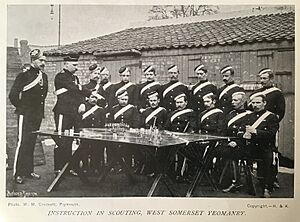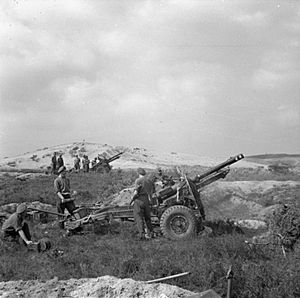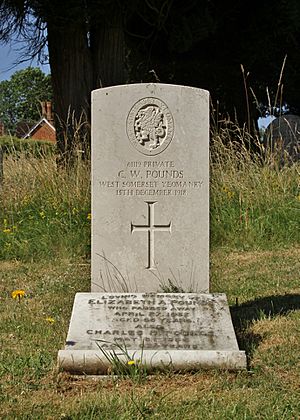West Somerset Yeomanry facts for kids
Quick facts for kids West Somerset Yeomanry |
|
|---|---|
| Active | June 1794–9 November 1988 2014–Present |
| Country | |
| Branch | |
| Type | Yeomanry |
| Size | Regiment |
| Part of | Boer War Imperial Yeomanry World War I Yeomanry Infantry World War II Royal Artillery |
| Garrison/HQ | Taunton |
| Engagements | Boer War
World War I World War II
|
The West Somerset Yeomanry was a special kind of volunteer army unit in the British Army. It was first formed in 1794. This unit, made up of cavalry (soldiers on horseback), fought in the Second Boer War and World War I. Later, it changed into an artillery unit, which means they used large guns. They also served in World War II. Over time, the unit became smaller and its original history as a yeomanry unit officially ended in 1988. However, a new unit using the "Somerset Yeomanry" name was formed in 2014.
Contents
- Early Days: Protecting Britain (1794–1831)
- Imperial Yeomanry: Fighting in South Africa
- Territorial Force: Preparing for War
- World War I: A Global Conflict
- Between the Wars: Becoming Artillery
- World War II: Two Regiments in Action
- After the Wars: Changes and Disbandment
- Unit History and Symbols
- See also
Early Days: Protecting Britain (1794–1831)
Around 1793, Britain was worried about being invaded by France. The government needed more soldiers to protect the country. So, in 1794, they asked for volunteers to form special groups called "Gentlemen and Yeomanry Cavalry." These were mounted (horseback) volunteers who could be called upon by the King to defend against invasion or by local leaders to help keep peace and order.
The first group of these volunteers in Somerset was started in Bridgwater in June 1794. By 1798, three more groups had joined, and they officially became the West Somersetshire Yeomanry Cavalry.
Even after the Napoleonic Wars ended in 1815, the government kept the Yeomanry. They were needed because there were no organized police forces yet. They helped the local authorities keep order. As police forces grew, the Yeomanry were needed less often. Many units were disbanded because the government didn't want to pay for them. But the West Somerset Yeomanry kept going, even without pay, from 1828 to 1831.
However, new problems and unrest across Britain in 1830 meant the Yeomanry became important again. The West Somerset Yeomanry was reorganized in 1831. Charles Kemeys Kemeys-Tynte, a Member of Parliament for Bridgwater, became their leader.
By 1893, Yeomanry groups were organized into brigades for training. The West Somerset Yeomanry and the North Somerset Yeomanry formed the 4th Yeomanry Brigade. This helped them train together and be ready for action.
Imperial Yeomanry: Fighting in South Africa
In December 1899, Britain faced tough times in the Second Boer War in South Africa. The government realized they needed more soldiers. So, they created the Imperial Yeomanry (IY). This new group allowed volunteers to join the fight. Existing Yeomanry units were asked to send companies (groups of about 115 men) who were trained to fight on horseback.
The West Somerset Yeomanry sent its own group, the 25th (West Somerset) Company. This company joined the 7th Battalion of the Imperial Yeomanry and sailed to South Africa in March 1900.
When they arrived, the 7th Battalion joined other Yeomanry units. They took part in major advances, but units were often reorganized. By mid-April, the 7th Battalion was fighting under Major-General John Brabazon. They tried to outflank (go around the side of) the Boer forces but were pushed back by enemy fire. After the Boers left the town of Dewetsdorp, Brabazon's group went to help the soldiers stuck in Wepener.
From September 1900, the war changed to guerrilla warfare, with smaller groups fighting. The mounted troops, like the Yeomanry, chased down Boer groups and protected supply convoys. After a year of service, the first Imperial Yeomanry volunteers went home. New recruits from England filled their places.
The 25th Company earned the West Somerset Yeomanry its first special honor: South Africa 1900–01. This showed their bravery in the war.
The Imperial Yeomanry were very successful. Because of this, all existing Yeomanry units back home were changed into Imperial Yeomanry. The West Somerset Yeomanry became the West Somerset Imperial Yeomanry in April 1901.
Territorial Force: Preparing for War
In 1908, the Imperial Yeomanry became part of a new army group called the Territorial Force (TF). On April 1, 1908, the unit was renamed the West Somerset Yeomanry again. Their main base was in Taunton. They were part of the 2nd South Western Mounted Brigade.
The regiment was organized into different squadrons (smaller groups of soldiers) based in towns across Somerset:
- HQ in Taunton
- A Squadron in Wellington
- B Squadron in Taunton
- C Squadron in Bridgwater
- D Squadron in Yeovil
World War I: A Global Conflict
When World War I began on August 4, 1914, the West Somerset Yeomanry gathered in Taunton. They then moved to Winchester and later to the Colchester area in Essex.
At the start of the war, the Territorial Force was meant for home defense. But many soldiers volunteered to serve overseas. To handle this, units were split. Those who volunteered for overseas service formed "1st Line" units. Those who stayed for home defense formed "2nd Line" units. Later, a "3rd Line" was created to train new soldiers as replacements.
1/1st West Somerset Yeomanry: Fighting Overseas
The 1/1st West Somerset Yeomanry stayed in Essex for about a year. In August 1915, they were chosen to go to Gallipoli, a peninsula in Turkey, to help other British forces. They left their horses behind and traveled by ship, arriving at Mudros on October 1.
Gallipoli 1915: Tough Battles
The unit landed at Suvla Bay on October 9. They started digging trenches and faced their first casualties. On November 3, they went into the main firing line for the first time. They fought in difficult conditions, including a severe storm that turned into a blizzard in late November. Many soldiers suffered from the cold and illness, as well as battle injuries.
By December, the unit's strength was very low. The decision was made to leave Gallipoli. The 1/1st West Somerset Yeomanry was among the last units to leave Suvla Bay on the night of December 19/20. The evacuation was a secret success, with no casualties during the withdrawal. The regiment then sailed to Egypt.
Egypt 1916–17: New Roles
In December 1915, the regiment arrived in Alexandria, Egypt. In February 1916, they became part of the 2nd Dismounted Brigade. They were involved in the Senussi Campaign in Egypt's Western Desert, which was almost over by April. The dismounted brigades helped guard the frontier and supply lines.
By the end of 1916, the 2nd Dismounted Brigade was helping defend the Suez Canal. The British army in Egypt was preparing to invade Palestine. So, the dismounted Yeomanry units were turned into a new infantry (foot soldier) division. On January 4, 1917, the 1/1st West Somerset Yeomanry became the 12th (West Somerset Yeomanry) Battalion, Somerset Light Infantry. They joined the new 74th (Yeomanry) Division.
Palestine 1917–18: Advancing Through Deserts and Hills
The 74th (Yeomanry) Division was ready for the Second Battle of Gaza in April 1917. They were in reserve and didn't fight much in that battle. But they trained hard for the Third Battle of Gaza, which began on October 27.
On October 30/31, the 74th (Yeomanry) Division marched at night to attack Beersheba from the side, while other forces attacked Gaza City. The Battle of Beersheba was a big success. The 74th Division then pushed on, attacking the Sheria Position on November 8. They captured strongpoints and drove back enemy counter-attacks.
The division then moved into the Judaean Hills towards Jerusalem. The Turks launched strong counter-attacks, but the 74th (Yeomanry) Division helped reinforce the line. On December 8, the British launched their final attack on Jerusalem. The 12th (West Somerset Yeomanry) Battalion helped capture a Turkish trench with many prisoners. The next day, Jerusalem surrendered.
The 74th (Yeomanry) Division's last battle in this campaign was the Battle of Tell 'Asur in March 1918. After this, they were told to move to the Western Front in France, where the German army was launching a big attack. By April 30, 1918, the division had left Egypt.
France and Flanders 1918: The Final Push
On May 7, 1918, the 12th (West Somerset Yeomanry) Battalion landed in Marseilles, France. They trained for fighting on the Western Front, learning about things like anti-gas measures.
The Allies launched their final big attack, the Hundred Days Offensive, in August. On September 2, the 12th (West Somerset Yeomanry) Battalion fought in the Second Battle of Bapaume. They had to clear enemy machine gun posts and capture their starting trench. They even captured a village that was an objective for another unit before calmly continuing their advance.
The British army then chased the Germans back towards the Hindenburg Line. The 74th (Yeomanry) Division reached Ronssoy Wood on September 8. They then fought in the Battle of Épehy on September 18, helping to capture key objectives.
The 74th (Yeomanry) Division returned to the front line in early October, joining the pursuit of the Germans towards the River Scheldt. They faced tough resistance, especially when crossing the Haute Deûle Canal. They drove German snipers out of towns and pushed the enemy back. On October 20, they approached Tournai, but resistance was strong.
On November 8, the enemy finally left their positions, and the 74th (Yeomanry) Division occupied Tournai. The next day, they continued to advance. On November 11, the division crossed the Dendre Canal and occupied Ath at 8:30 AM. At 11:00 AM, the Armistice with Germany came into effect, ending the war.
After the war, the soldiers helped repair railways. From February 1919, soldiers started going home. The remaining small group of the 12th (West Somerset Yeomanry) Battalion returned to Taunton and was officially disbanded on June 20, 1919.
2/1st West Somerset Yeomanry: Home Defense and Cyclists
The "2nd Line" regiment was formed in Taunton in 1914. In January 1915, they joined the 2/2nd South Western Mounted Brigade. In July 1916, most of the 2nd Line Yeomanry units were dismounted, meaning their horses were sent away. Instead, they were given bicycles and became "yeomanry cyclist regiments."
The 2/1st West Somerset Yeomanry became part of the 1st Cyclist Division in Suffolk. In November 1916, they merged with another unit to form the 5th (West Somerset and City of London) Yeomanry Cyclist Regiment. Later, in March 1917, they became the 2/1st West Somerset Yeomanry again. They stayed in Norfolk until May 1918, when they moved to Ireland and remained there until the war ended.
The 2/1st West Somerset Yeomanry was disbanded on November 24, 1919.
3/1st West Somerset Yeomanry: Training Replacements
The "3rd Line" regiment was formed in 1915. Their job was to train new soldiers to replace those fighting in the 1st and 2nd Line units. In July 1916, they were also dismounted. They were disbanded in early 1917, and their soldiers joined the 2nd Line regiment or other reserve battalions.
Between the Wars: Becoming Artillery
After World War I, the Territorial Force was reorganized. Only the most senior Yeomanry regiments stayed as cavalry. The others, including the West Somerset Yeomanry, changed roles. On June 1, 1920, the West Somerset Yeomanry became an artillery unit, using big guns. They were named the 1st (Somerset) Army Brigade, RFA.
In 1921, this unit was renamed the 94th (Somerset Yeomanry) Brigade, RFA. In 1922, they merged with the Dorset Yeomanry to form the 94th (Dorset & Somerset Yeomanry) Bde, RFA. This unit had its headquarters in Taunton and batteries (groups of guns) in Taunton, Glastonbury, Blandford Forum, and Sherborne. In 1924, the RFA became part of the Royal Artillery (RA).
In 1929, the Somerset Yeomanry batteries moved to the 55th (Wessex) Army Field Brigade, RA. This new unit had its headquarters in Taunton and batteries in Swindon, Taunton, and Glastonbury (later Shepton Mallet). These units used 18-pounder guns and 4.5-inch howitzers, which were types of artillery guns from World War I.
In 1938, the RA changed its names, and brigades became "regiments." So, the 55th (Wessex) Field Brigade became the 55th (Wessex) Field Regiment, RA.
World War II: Two Regiments in Action
Before World War II began, the Territorial Army doubled in size. The 55th (Wessex) Field Regiment split into two. The Wiltshire batteries formed the 112th Field Regiment. The 55th (Wessex) Field Regiment (often called the 'West Somerset Yeomanry') joined the new 45th Division.
Artillery regiments were reorganized to have two batteries, each with three groups of four guns. Later, they changed again to have three batteries, each with eight guns.
55th (Wessex) Field Regiment: Fighting in Europe
At the start of the war, the 55th Field Regiment helped defend Britain from invasion. In June 1942, the regiment joined the Guards Armoured Division. They landed in Normandy, France, in June 1944, shortly after D-Day.
They fought bravely throughout the campaign in North West Europe until the war ended. This included major operations like Epsom, Goodwood, and Bluecoat in Normandy, the attempt to capture the Arnhem bridge (Operation Market Garden), and battles in Germany like Operation Veritable and the crossing of the River Ems. The unit was often called the "West Somerset Yeomanry," showing they kept their historical name.
112th (Wessex) Field Regiment: Supporting Divisions
The 112th (Wessex) Field Regiment stayed in the UK for most of the war. They formed their third battery in March 1941. They were allowed to use the "Wessex" name from February 1942.
This regiment also went to Normandy after D-Day in June 1944. They took part in many operations, including Epsom, Jupiter, and Bluecoat in Normandy, crossing the Seine river, fighting in Arnhem (Operation Market Garden), and then battles across Germany until the war ended.
After the Wars: Changes and Disbandment
After World War II, the 55th (Wessex) Field Regiment was reformed in 1947 as the 255 (Wessex) Medium Regiment. Its headquarters moved to Shepton Mallet, then back to Taunton.
In 1950, it absorbed another regiment, the 663 (Somerset) Super Heavy Regiment. In 1956, it merged with the 421 (Dorset) Coast Regiment, becoming the 255 (West Somerset Yeomanry and Dorset Garrison) Medium Regiment.
In 1961, it merged again with the 294 (Queen's Own Dorset Yeomanry) Field Regiment to form the 250 Queen's Own Dorset & West Somerset Yeomanry) Medium Regiment.
When the Territorial Army was reorganized in 1967, part of this unit became 'B' (West Somerset Yeomanry) Company. It was no longer an artillery unit but part of the Somerset Yeomanry and Light Infantry (Territorials).
On April 1, 1969, the battalion was reduced to a small core group. However, on April 1, 1971, this core group was disbanded and reformed as two companies of the 6th (Volunteer) Battalion, The Light Infantry. 'B' (Somerset Yeomanry Light Infantry) Company, based in Yeovil, continued the history of the West Somerset Yeomanry.
Finally, on November 9, 1988, the special names for the companies were removed, and the direct history of the yeomanry unit officially ended.
However, in 2013, it was announced that a new artillery unit, the 255 (Somerset Yeomanry) Battery Royal Artillery, would be formed in 2014. While it uses the Somerset Yeomanry name, it does not directly continue the old unit's history.
Unit History and Symbols
Leaders
Many important leaders served the West Somerset Yeomanry over the years:
- Colonel Charles Kemeys Tynte, appointed in 1831.
- The Hon William Portman (later 2nd Viscount Portman), appointed in 1854.
- Colonel W. Barrett, appointed Honorary Colonel in 1911.
- Brigadier-General E. Harding Newman, appointed Honorary Colonel of the 55th (Wessex) Field Brigade in 1931.
Uniforms and Badges
The West Somerset Yeomanry wore a special uniform called a Hussar-style uniform for formal events. It had a dark blue jacket with red parts and six rows of cords across the chest. They wore a tall, furry hat called a busby with a red bag and a white feather.
Their cap badge had a Wyvern (a dragon-like creature) inside a strap with the words 'WEST SOMERSET YEOMANRY'. After the Second Boer War, they added a scroll below the badge that said 'S. AFRICA 1900–01'.
When the unit became an artillery unit, they started wearing the badges of the Royal Artillery. However, after World War II, the 255 Medium Regiment wore a blue patch on their shoulder with 'WSY' (for West Somerset Yeomanry) in yellow, below the 'ROYAL ARTILLERY' in red. After merging to form the 250 Medium Regiment, this changed to 'W.S.Y.& D.G'.
Battle Honors: Recognizing Bravery
The West Somerset Yeomanry earned special "battle honors" for their bravery in different wars:
- Second Boer War
- World War I
Somme 1918, Bapaume 1918, Hindenburg Line, Épéhy, Pursuit to Mons, France and Flanders 1918, Gallipoli 1915, Egypt 1916–17, Gaza, Jerusalem, Tell 'Asur, Palestine 1917–18
- World War II
Artillery units usually don't get specific battle honors. Instead, their motto Ubique (which means 'Everywhere') covers all their service.
See also
- Imperial Yeomanry
- List of Yeomanry Regiments 1908
- Yeomanry
- Yeomanry order of precedence
- British yeomanry during the First World War
- Second line yeomanry regiments of the British Army
- List of British Army Yeomanry Regiments converted to Royal Artillery





